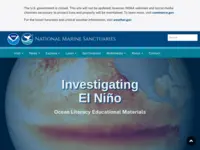Investigating El Niño and Impacts of Changing Ocean Temperatures
https://sanctuaries.noaa.gov/education/teachers/ocean-mysteries/changing-ocean-temperature.html
https://sanctuaries.noaa.gov/education/teachers/ocean-mysteries/changing-ocean-temperature.html
National Oceanic and Atmospheric Administration
This activity presents background information about El Niño and La Niña and then guides students through exploring sea surface temperature data and noticing patterns. Students learn how the ocean temperatures moderate climate (through radiation absorbed by the sun) and how changing temperatures not only impact our climate but also marine life/habitat. Students analyze and graph ocean temperature data from NOAA View Global Data Explorer, comparing different areas of the world.
This learning activity takes one 45 minute class period.
Learn more about Teaching Climate Literacy and Energy Awareness»Grade Level
Regional Focus
Online Readiness
Energy Literacy
This Activity builds on the following concepts of Energy Literacy.
Click a topic below for supporting information, teaching ideas, and sample activities.
Notes From Our Reviewers
The CLEAN collection is hand-picked and rigorously reviewed for scientific accuracy and classroom effectiveness.
Read what our review team had to say about this resource below or learn more about
how CLEAN reviews teaching materials
Teaching Tips | Science | Pedagogy |
Technical Details
Teaching Tips
- If students have never used an interactive map, the teacher may want to demonstrate this in more depth than the instructions suggest.
- The activity encourages but does not require students to graph the data. Graphing the data, however, provides excellent practice and an opportunity to see the power of graphs compared with tables of data.
- Teachers should take time to review the enrich/extend opportunities.
About the Content
- This lesson does an excellent job of modeling the scientific process by having students "collect" data, encouraging them to graph the data, and asking them to draw conclusions.
- The activity uses real, high-quality data from an interactive map from a credible source (NOAA) and includes both historical and current data.
- The activity provides links to high-quality background information that is written at an accessible level and could be useful for both the teacher and the students.
- Background information provides plenty of content for those who want to dig deeper. The rigor of the lesson seems appropriate.
- Passed initial science review - expert science review pending.
About the Pedagogy
- The activity provides students with an opportunity to learn how to interact with real data in a GIS and draw conclusions from evidence, meeting the learning objectives.
- Brings in ocean chlorophyll concentration data and asks students to make inferences about impacts based on this data together with temperature data.
- The map itself is quite clear and uncluttered. The teaching sequence makes a lot of sense: the teacher provides background and demonstrates the map, students then explore the map and gather data from it, then they graph the data, view additional data, and draw conclusions.
- The lesson is part of a series, and there is some indication previous lessons about the ocean should be completed beforehand - including lessons about ocean currents and trade winds. Students should have some computer proficiency to execute the objectives of this lesson. The Data Explorer Program, which enables students to virtually travel around the ocean, should be fun and engaging for students.
- This resource engages students in using scientific data.
See other data-rich activities
Technical Details/Ease of Use
- The data are readily accessible and the instructions for using the map to explore data are very clear and accurate.
- Students would be exploring online data, so the activity requires a stable internet connection. It also requires access to a computer. Overall the activity is highly usable and I would not expect it to take a lot of preparation time. The background information consists of reading for the teacher and links to articles that both the teacher and students could use.
- There is no cost associated with this lesson. Teachers need to spend some time familiarizing themselves with the Data Explorer Program to learn how to view/add features. The resource includes a two-minute video which explains how to use the program.
- The lesson does not provide suggestions for working with diverse learners, although it does suggest working through the handout activities as a class if students need more support.








